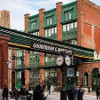The Distillery, Toronto, ON, Canada
Notes:
 Location : Latitude: 43.650243813168714, Longitude: -79.3591884613038
Location : Latitude: 43.650243813168714, Longitude: -79.3591884613038
Media
| Photos | 1869_Great_Fire_of_69.jpg | |
 | Toronto's Distillery District: history by the lake
by Gibson, Sally, 1946- A new book by Toronto archivist and historian Sally Gibson explores the Distillery District | |
 | Fire engine 1869.jpg | |
 | "Grist to the Mill, Toronto Winter, 1835" Print of a painting by Rowley Murphy, 1947. The print depicts an imagined scene of the Gooderham and Worts windmill, as it might have looked in 1835. | |
 | pumping water.jpg | |
| Surreal calm 1870.jpg | ||
 | Alcohol in Industry by Gooderham & Worts, limited. Year/Format: 1938, Book , 26 p. : Subjects: Alcohol. Private Press and Fine Printing Collection : PPFPC Publication information: Toronto : Gooderham & Worts, ltd., [c1938]. Language: English Corporate Author: Gooderham & Worts, limited. Added author: Brigdens (Firm) | |
 | Booze Boats and Billions by C.W. Hunt Year/Format: 1988, Book, 351 p., [16] p. of plates : Subjects: Distilling industries--Ontario--History. Hatch family. Prohibition--Ontario--History--20th century. Prohibition--United States--History--20th century. Smuggling--Ontario--History--20th century. Smuggling--United States--History--20th… | |
| Toronto, in the Summer of 1851 by Francis Hincks Granger (1827-1915). Toronto, in the Summer of 1851 Francis Hincks Granger (1827-1915). Watercolour. 43.2 cm x 137.2 cm. TPL (TRL) Acc. JRR 341 Looking westward from Gooderham & Worts' mill on Trinity Street to Fort York on the far left. The artist, Francis Hincks Granger, was a scene painter for the Royal Lyceum Theatre, Toronto. (1-3) Wharf and storehouse, mill… | ||
 | Taylor's Wharf, 1835 by John George Howard This view shows Taylor's Wharf at the foot of Frederick Street (in the mid background) and the Gooderham windmill (right background). The mill was unusual because most industry in Georgian Canada favoured waterpower. John George Howard was an architect, surveyor and drawing master. He arrived in York in 1832, the same year as William Gooderham,… | |
 | Toronto 1834 By Owen Staples Owen Staples, also known as Owen Poe Staples (September 3, 1866 - December 6, 1949), was a Canadian painter, etcher, pastelist, political cartoonist, author, musician and naturalist. From 1888 to 1908, Staples worked for the Telegram as a staff artist, reporter and political cartoonist, and illustrator for the J. Ross Robertson Collection. | |
 | Canadian Whisky, Second Edition: The New Portable Expert Davin de Kergommeaux takes readers on a journey through the first systematic presentation of Canadian whisky: how it's made, who makes it, why it has its own unique flavours, its history, culture and the rich centuries of folklore surrounding it. One chapter discusses the contribution of the Gooderham and Worts Distillery to this early history. | |
| Gooderham & Worts cattle sheds Detail from “City of Toronto, 1893.” The Gooderham & Worts cattle sheds are immediately east of the bend in the river, north of the marsh. Toronto Public Library, TRL, Historical Picture Collection, 916-2-1. | ||
 | Gooderham and Worts cattle sheds map Gooderham & Worts Distillery at Front and Trinity Streets, 1858. Note the five cattle sheds on the east side of Trinity Street, opposite the mill buildings. Source: W.S. Boulton and H.C. Boulton, Atlas of the City of Toronto and vicinity, Toronto: J.Ellis, 1858, Special Collections, TRL, Toronto Public Library. | |
 | Survivals: Aspects of Industrial Archaeology in Ontario
by Newell, Dianne and Greenhill, Ralph., Erin, Ont: Boston Mills Press, 1989. Pp. 225. Illustrations, select bibliography, and index. Newell, Dianne and Greenhill, Ralph., Survivals: Aspects of Industrial Archaeology in Ontario. Erin, Ont: Boston Mills Press, 1989. Pp. 225. Illustrations, select bibliography, and index. $39.50. This attractive book is the joint effort of two long time workers in Canadian engineering and technological history. One is Dianne Newell who has… |
| Documents |  | Gooderham Family Bible found in Distillery Dinah Cruse-Hunter, whose 4th g-grandmother was a sister-in-law to William Gooderham’s son, Alfred Edward Gooderham, was given this bible by a friend who rescued it from under the feet of a worker at the Distillery District. Dinah writes the following about the bible: My husband and I have been historical re-enactors for the past 15 years or… |
 | G & W historic sources adapted from report by Stephen A. Otto, 1994. When developers created The Distillery District from the Gooderham & Worts distillery, Stephen Otto researched the history of the business and the people who built it. This is an adapted version of Stephen Otto's report on sources of archival materials on the Gooderham and Worts families. |
| Histories |  | 2. Inventory of Archival Sources
The Gooderham and Worts Distillery was redeveloped and renamed The Distillery District. The site is designated a National Historic Site. In the process, the developers created a website to capture the sites history, including that of its founders, at www.distilleryheritage.com The source material relating to the Gooderham family on this site is… |
 | The Windmill and Its Times This is a link to The Windmill and Its Times by E.B. Shuttleworth |
| Videos | Distillery District This video is a promotional video for the Entertainment district built in the restored G&W Distillery. |
| Family Stories |  | 1834 This is a Yankee Place A story about selling wheat to the Gooderham Mill. |
 | 1837 Mr. Cawthra's Bags of Gold According to Louisa Gooderham Walker Score, during the rebellion, the mill was used to store articles of value and “Mr. Cawthra’s bags of gold” | |
| 1869 Great Fire of ‘69 At six o’clock on Tuesday, October 26, 1869 – just as William Gooderham and his family were sitting down for dinner (or “tea”) – a small cask of benzene caught fire and exploded in the fermenting cellar of his 1860 Stone Distillery, precipitating a night of high drama by the Lake. Sally Gibson, The Distillery Archivist tells this… | ||
| 1880 Tons of Cow Poop Gooderham began fattening cattle and hogs in the late 1830s, and by 1841 he had established a large dairy on a nine acre site between Trinity and Cherry Streets, across from the mill. |
No results found.
